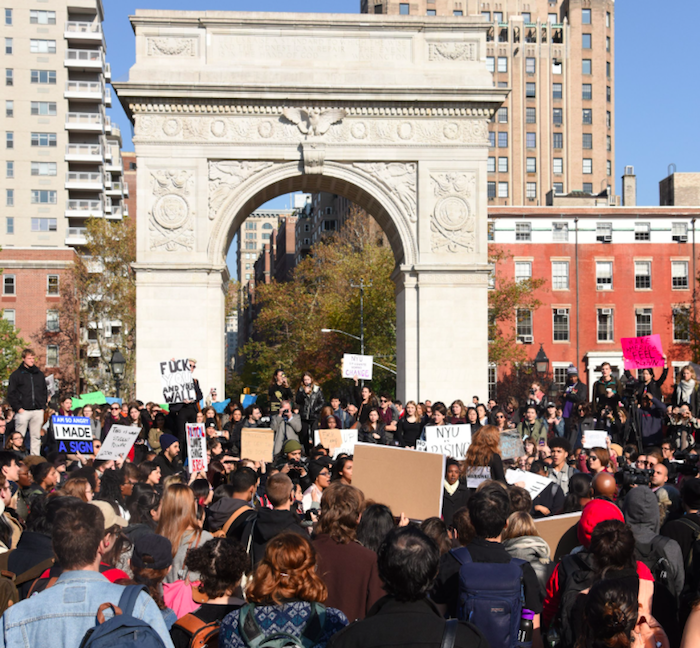Are We Seeing the Birth of a New Student Movement?

Photo by Caroline de Quesada
The wave of anti-Trump protests that swept across America’s college campuses (and high schools) after the election suggests that a new national student movement is emerging. And it has arisen with astonishing speed.
Donald Trump and his entourage seem unable or unwilling to come to grips with the origins and significance of these protests. In fact their responses have been dismissive or worse. Trump surrogate Rudy Giuliani dismissed the protesters as “spoiled crybabies,” while Trump senior adviser Kellyanne Conway charged that they “degrade the office of the presidency.” Trump himself initially tweeted that the demonstrations erupted because of “professional protesters inspired by the media.” Such comments missed the human rights and immigrant rights motivations and focus of many of the student protests, whose central goal was defensive, protecting students from Trump’s nativist threats, rather than offensive or partisan.
Recently the students at my university, NYU, held an anti-Trump rally, which drew hundreds of students and faculty, that was part of a national day of action to have universities declare themselves sanctuaries that would resist the Trump administration should it deliver on his campaign promise to deport millions of undocumented immigrants.
This issue is of immediate concern on my campus and many others because we have undocumented students in both our undergraduate and professional schools, thanks to DACA (Consideration for Deferred Action for Childhood Arrivals), the program created by the Obama administration. The rally above all represented an act of solidarity as students pledged that they would not be passive while their immigrant classmates were threatened by Trump.
Even the logistics of the rally were arranged so as to symbolize this solidarity. The mostly immigrant student speakers, including an eloquent undocumented NYU Law student, orated from the center of the fountain at Washington Square Park while their classmates formed a human circle around them symbolizing a determination to protect them. As one of my students, who served as a marshal at the rally, explained, this demonstration represented “ more than just the call for reforming the legal sanctuary status of the university …. it felt to me, this rally was about cultivating a culture of responsibility and accountability for each others’ safety and security.”
The rally speakers mostly avoided sloganizing, and instead offered detailed autobiographical stories of their struggles to achieve the American dream, excelling in school despite the hardships of working class and undocumented immigrant life. They told of their fears of losing their educational opportunities and their families should Trump’s deportation threats be realized. Their speeches ended with the crowd chanting “NYU if you really want to look great. Tell ICE [Immigration and Customs Enforcement] that you refuse to cooperate,.” “When immigrant rights are under attack. What do we do? Stand Up, Fight Back.” “We love you, we support you, we will put our bodies on the line for you.”
When the rally ended hundreds of students, led by the demonstration’s marshals marched, from the park and crossed the street to NYU’s Bobst Library, where they stood in silence in a non-disruptive 10 minute vigil in the lobby of the library, hoisting their anti-Trump and immigrant rights picket signs.
Among the more remarkable aspects of this rally was how many of the participants were new to student protest. Many of the students I interviewed during and after the rally told me this was their first demonstration at college. Even some of the speakers at the rally mentioned that this was their first protest, with one even noting that prior to Trump’s election he had avoided political discussions. A rally organizer confided that since the protest was put together so quickly she initially expected only the small “normal social justice crowd,” and was startled to learn via Facebook that 600, then 800, then 900 clicked their intention to attend the rally, even though it was held at noon and so those attending would miss their classes.
What I witnessed at this student protest differed dramatically not only from the Trump camp’s put downs of such demonstrations, but also from the way middle age detractors of campus activists have long mocked millennials as a “coddled generation,” overly sensitive to racial or gender slights (known as “micro-aggressions”) and wrapped up in an insular campus world of political correctness.
Instead, the student protesters had their eyes on Trump’s threatened sweeping aggression against immigrants and were boldly challenging their university to join them in protecting their most vulnerable classmates from forced deportation by the Trump administration. In its seriousness, non-violence, and human rights concerns this NYU demonstration called to mind the sit-in movement of the early 1960s.
But while that earlier movement was putting forth a demand for expanding Black rights, this rally was more of a defensive pledge to resist what seems an imminent encroachment on immigrant rights. This fear of a new form of governmental oppression, and determination to resist it and protect the innocent among us was palpable at the rally. It reminded me not of any earlier American student movement I’ve studied in the past 30 years, but of a story I heard the late novelist Pat Conroy tell of his youthful response upon encountering The Diary of Anne Frank.
Moved and outraged by the story of this young victim of the Holocaust, the young Conroy had rushed out and pledged to a Jewish neighbor in South Carolina that he would hide her when the Nazis came. This mixture of youthful idealism and dread is new on the American campus scene, and it seems powerful enough to yield not only more protests but mass civil disobedience on campus should a President Trump be reckless enough to bring his deportation schemes through the college gates.
